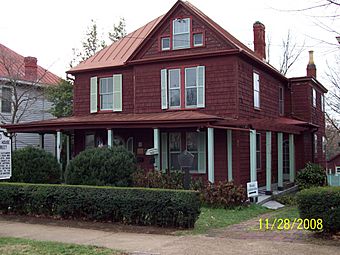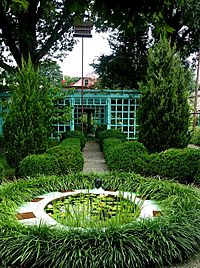Anne Spencer House facts for kids
|
Anne Spencer House
|
|
|
U.S. Historic district
Contributing property |
|

The Anne Spencer House in Lynchburg, Virginia. Photo from November 2008.
|
|
| Location | 1313 Pierce St., Lynchburg, Virginia |
|---|---|
| Area | less than one acre |
| Built | 1903 |
| Architectural style | Queen Anne |
| Part of | Pierce Street Historic District (ID14000527) |
| NRHP reference No. | 76002224 |
Quick facts for kids Significant dates |
|
| Added to NRHP | December 6, 1976 |
| Designated CP | August 25, 2014 |
The Anne Spencer House is a historic home and museum in Lynchburg, Virginia. From 1903 to 1975, it was the home of Anne Spencer, a famous poet from the Harlem Renaissance. The Harlem Renaissance was an exciting time in the 1920s and 1930s when African American art, music, and literature flourished. Today, you can visit her house to see where she lived and wrote.
Contents
A Tour of the Spencer House
The house on Pierce Street was built in 1903. It is a two-story home built in the Queen Anne style, which was popular at the time. Next to the house is a large garden and a special one-room cottage called Edankraal. This was Anne Spencer's private place to write her poems. The name "Edankraal" is a creative mix of the names Edward (her husband), Anne, and "kraal," an Afrikaans word for an enclosure.
Inside the House
The first floor has a living room, dining room, and kitchen. The front hall is decorated with mirrors and flowers, making it feel like a "garden of light and colors." A cool feature is a small phone booth built under the stairs.
The second floor has four bedrooms and a bathroom. The third floor was once a "man cave" for Anne's husband, Edward. It had a pool table and a small bathroom. Later, it became a room for their grandchildren when they visited.
Creative and Recycled Design
Edward Spencer was very creative and good at recycling. As his family grew, he made changes to the house using old materials. He turned a screened porch into a cozy den. He used old lattice from the porch to make a new entrance to the garden.
He also used leftover copper sheets from a department store to decorate the dining room walls. The kitchen doors were once bright red leather doors from a local movie theater. Edward even used large, old stair railings to build beds for his grandchildren in the attic. He was a master at turning unwanted items into something new and useful for his home.
Anne Spencer's Life in Lynchburg
Anne Spencer was a very important poet. She was the first African-American and the first Virginian to have her poetry included in a major collection called the Norton Anthology of American Poetry.
A Center for Change
Besides being a poet, Anne Spencer was a dedicated activist who fought for equal rights. Her home was a meeting place for people working to make the community better. She and her husband, Edward, helped start a local chapter of the National Association for the Advancement of Colored People (NAACP). The NAACP is an organization that works to protect the rights of African Americans.
The Spencers welcomed many famous and important people into their home. Their guests included leaders and artists like:
- Langston Hughes (poet)
- Marian Anderson (singer)
- George Washington Carver (scientist)
- Thurgood Marshall (lawyer and later a Supreme Court Justice)
- Martin Luther King Jr. (civil rights leader)
- W. E. B. Du Bois (writer and activist)
The House as a Museum
The Anne Spencer House was added to the National Register of Historic Places in 1976 because of its importance. It opened as a museum in 1977 so that people could learn about Anne Spencer's life and work.
In July 2022, the museum received a grant from the National Trust for Historic Preservation's African American Cultural Heritage Action Fund. This money was used to hire a director to manage the museum and plan for future restoration projects.




